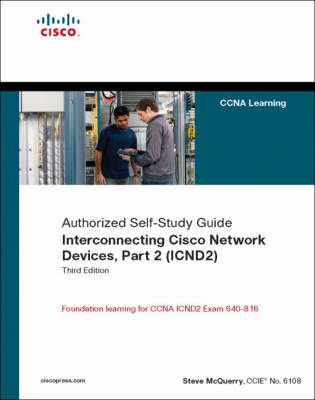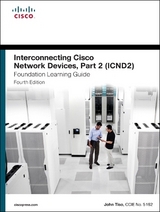
Interconnecting Cisco Network Devices, Part 2 (ICND2)
Cisco Press (Verlag)
978-1-58705-463-1 (ISBN)
- Titel erscheint in neuer Auflage
- Artikel merken
Interconnecting Cisco Network Devices, Part 2 (ICND2)
Third Edition
Foundation learning for CCNA ICND2 Exam 640-816
Steve McQuerry, CCIE® No. 6108
Interconnecting Cisco Network Devices, Part 2 (ICND2), is a Cisco®-authorized, self-paced learning tool for CCNA® foundation learning. This book provides you with the knowledge needed to install, operate, and troubleshoot a small to medium-size branch office enterprise network, including configuring several switches and routers, connecting to a WAN, and implementing network security.
In Interconnecting Cisco Network Devices, Part 2 (ICND2), you will study actual router and switch output to aid your understanding of how to configure these devices. Many notes, tips, and cautions are also spread throughout the book. Specific topics include constructing medium-size routed and switched networks, OSPF and EIGRP implementation, access control lists (ACL), address space management, and LAN extensions into a WAN. Chapter-ending review questions illustrate and help solidify the concepts presented in the book.
Whether you are preparing for CCNA certification or simply want to gain a better understanding of how to build medium-size Cisco networks, you will benefit from the foundation information presented in this book.
Interconnecting Cisco Network Devices, Part 2 (ICND2), is part of a recommended learning path from Cisco that includes simulation and hands-on training from authorized Cisco Learning Partners and self-study products from Cisco Press. To find out more about instructor-led training, e-learning, and hands-on instruction offered by authorized Cisco Learning Partners worldwide, please visit www.cisco.com/go/authorizedtraining.
Steve McQuerry, CCIE® No. 6108, is a consulting systems engineer with Cisco focused on data center architecture. Steve works with enterprise customers in the Midwestern United States to help them plan their data center architectures. He has been an active member of the internetworking community since 1991 and has held multiple certifications from Novell, Microsoft, and Cisco. Before joining Cisco Steve worked as an independent contractor with Global Knowledge, where he taught and developed coursework around Cisco technologies and certifications.
Review the Cisco IOS® Software command structure for routers and switches
Build LANs and understand how to overcome problems associated with Layer 2 switching
Evaluate the differences between link-state and distance vector routing protocols
Configure and troubleshoot OSPF in a single area
Configure and troubleshoot EIGRP
Identify and filter traffic with ACLs
Use Network Address Translation (NAT) and Port Address Translation (PAT) to conserve IPv4 address space and implement IPv6
Connect different sites over WANs or the Internet using IPsec VPN, SSL VPN, leased line, and Frame Relay connections
This volume is in the Certification Self-Study Series offered by Cisco Press®. Books in this series provide officially developed self-study solutions to help networking professionals understand technology implementations and prepare for the Cisco Career Certifications examinations.
Category: Cisco Press—Cisco Certification
Covers: ICND2 Exam 640-816
Steve McQuerry, CCIE No. 6108, is a consulting systems engineer with Cisco focused on data center architecture. Steve works with enterprise customers in the Midwestern United States to help them plan their data center architectures. Steve has been an active member of the internetworking community since 1991 and has held multiple certifications from Novell, Microsoft, and Cisco. Before joining Cisco, Steve worked as an independent contractor with Global Knowledge, where he taught and developed coursework around Cisco technologies and certifications.
Foreword
Introduction
Chapter 1 Review of Cisco IOS for Routers and Switches
Chapter Objectives 3
Cisco IOS CLI Functions 4
Configuration Modes of Cisco IOS Software 4
Help Facilities of the Cisco IOS CLI 6
Commands Review 7
Summary of Cisco IOS CLI Commands 8
Chapter Summary 8
Review Questions 8
Chapter 2 Medium-Sized Switched Network Construction
Chapter Objectives
Implementing VLANs and Trunks
Understanding VLANs
VLAN Overview
Grouping Business Functions into VLANs
Applying IP Address Space in the Enterprise Network
Example: Network Design
Considering Traffic Source to Destination Paths
Voice VLAN Essentials
VLAN Operation
Understanding Trunking with 802.1Q
802.1Q Frame
802.1Q Native VLAN
Understanding VLAN Trunking Protocol
VTP Modes
VTP Operation
VTP Pruning
Configuring VLANs and Trunks
VTP Configuration
Example: VTP Configuration
802.1Q Trunking Configuration
VLAN Creation
VLAN Port Assignment
Adds, Moves, and Changes for VLANs
Adding VLANs and Port Membership
Changing VLANs and Port Membership
Deleting VLANs and Port Membership
Summary of Implementing VLANs and Trunks
Improving Performance with Spanning Tree
Building a Redundant Switched Topology
Choosing Interconnection Technologies
Determining Equipment and Cabling Needs
EtherChannel Overview
Redundant Topology
Recognizing Issues of a Redundant Switched Topology
Switch Behavior with Broadcast Frames
Broadcast Storms
Example: Broadcast Storms
Multiple Frame Transmissions
Example: Multiple Transmissions
MAC Database Instability
Resolving Issues with STP
Spanning-Tree Operation
Example: Selecting the Root Bridge
Example: Spanning-Tree Operation
Example: Spanning-Tree Path Cost
Example: Spanning-Tree Recalculation
STP Convergence
Per VLAN Spanning Tree+
PVST+ Operation
Rapid Spanning Tree Protocol
Per VLAN RSTP
Multiple Spanning Tree Protocol
RSTP Port Roles
Configuring RSTP
Summary of Improving Performance with Spanning Tree
Routing Between VLANs
Understanding Inter-VLAN Routing
Example: Router on a Stick
Example: Subinterfaces
Configuring Inter-VLAN Routing
Summary of Routing Between VLANs
Securing the Expanded Network
Overview of Switch Security Concerns
Securing Switch Devices
Securing Switch Protocols
Mitigating Compromises Launched Through a Switch
Describing Port Security
802.X Port-Based Authentication
Summary of Securing the Expanded Network
Troubleshooting Switched Networks
Troubleshooting Switches
Troubleshooting Port Connectivity
Hardware Issues
Configuration Issues
Troubleshooting VLANs and Trunking
Native VLAN Mismatches
Trunk Mode Mismatches
VLANs and IP Subnets
Inter-VLAN Connectivity
Troubleshooting VTP
Unable to See VLAN Details in the show run Command Output
Cisco Catalyst Switches Do Not Exchange VTP Information
Recently Installed Switch Causes Network Problems
All Ports Inactive After Power Cycle
Troubleshooting Spanning Tree
Use the Diagram of the Network
Identify a Bridging Loop
Log STP Events
Temporarily Disable Unnecessary Features
Designate the Root Bridge
Verify the Configuration of RSTP
Summary of Troubleshooting Switched Networks
Chapter Summary
Review Questions
Chapter 3 Medium-Sized Routed Network Construction
Chapter Objectives
Reviewing Dynamic Routing
Understanding Distance Vector Routing Protocols
Route Discovery, Selection, and Maintenance
Routing Loops
Route Maintenance Using Hold-Down Timers
Route Maintenance Using Triggered Updates
Route Maintenance Using Hold-Down Timers with Triggered Updates
Link-State and Advanced Distance Vector Protocols
Link-State Routing Protocol Algorithms
Advanced Distance Vector Protocol Algorithm
Summary of Reviewing Routing Operations
Implementing Variable-Length Subnet Masks
Reviewing Subnets
Computing Usable Subnetworks and Hosts
Introducing VLSMs
Route Summarization with VLSM
Summary of Implementing Variable-Length Subnet Masks
Chapter Summary
Review Questions
Chapter 4 Single-Area OSPF Implementation
Chapter Objectives
Introducing OSPF
Establishing OSPF Neighbor Adjacencies
SPF Algorithm
Configuring and Verifying OSPF
Loopback Interfaces
Verifying the OSPF Configuration
Using OSPF debug Commands
Load Balancing with OSPF
OSPF Authentication
Types of Authentication
Configuring Plaintext Password Authentication
Example: Plaintext Password Authentication Configuration
Verifying Plaintext Password Authentication
Summary of OSPF Introduction
Troubleshooting OSPF
Components of Troubleshooting OSPF
Troubleshooting OSPF Neighbor Adjacencies
Troubleshooting OSPF Routing Tables
Troubleshooting Plaintext Password Authentication
Summary of Troubleshooting OSPF
Chapter Summary
Review Questions
Chapter 5 Implementing EIGRP
Chapter Objectives
Implementing EIGRP
Introducing EIGRP
Configuring and Verifying EIGRP
Load Balancing with EIGRP
EIGRP Metric
Load Balancing Across Equal Paths
Configuring Load Balancing Across Unequal-Cost Paths
Example: Variance
EIGRP Authentication
Creating a Key Chain
Configuring MD5 Authentication for EIGRP
Example: MD5 Authentication Configuration
Verifying MD5 Authentication
Summary of Implementing EIGRP
Troubleshooting EIGRP
Components of Troubleshooting EIGRP
Troubleshooting EIGRP Neighbor Relationships
Troubleshooting EIGRP Routing Tables
Troubleshooting EIGRP Authentication
Example: Successful MD5 Authentication
Example: Troubleshooting MD5 Authentication Problems
Summary of Troubleshooting EIGRP
Chapter Summary
Review Questions
Chapter 6 Managing Traffic with Access Control Lists
Chapter Objectives
Access Control List Operation
Understanding ACLs
ACL Operation
Types of ACLs
ACL Identification
Additional Types of ACLs
Dynamic ACLs
Reflexive ACLs
Time-Based ACLs
ACL Wildcard Masking
Summary of ACL Operations
Configuring ACLs
Configuring Numbered Standard IPv4 ACLs
Example: Numbered Standard IPv4 ACL—Permit My Network Only
Example: Numbered Standard IPv4 ACL—Deny a Specific Host
Example: Numbered Standard IPv4 ACL—Deny a Specific Subnet
Controlling Access to the Router Using ACLs
Configuring Numbered Extended IPv4 ACLs
Extended ACL with the established Parameter
Numbered Extended IP ACL: Deny FTP from Subnets
Numbered Extended ACL: Deny Only Telnet from Subnet
Configuring Named ACLs
Creating Named Standard IP ACLs
Creating Named Extended IP ACLs
Named Extended ACL: Deny a Single Host from a Given Subnet
Named Extended ACL—Deny a Telnet from a Subnet
Adding Comments to Named or Numbered ACLs
Summary of Configuring ACLs
Troubleshooting ACLs
Problem: Host Connectivity
Summary of Troubleshooting ACLs
Chapter Summary
Review Questions
Chapter 7 Managing Address Spaces with NAT and IPv6
Chapter Objectives
Scaling the Network with NAT and PAT
Introducing NAT and PAT
Translating Inside Source Addresses
Static NAT Address Mapping
Dynamic Address Translation
Overloading an Inside Global Address
Resolving Translation Table Issues
Resolving Issues with Using the Correct Translation Entry
Summary of Scaling the Network with NAT and PAT
Transitioning to IPv6
Reasons for Using IPv6
Understanding IPv6 Addresses
Global Addresses
Reserved Addresses
Private Addresses
Loopback Address
Unspecified Address
IPv6 over Data Link Layers
Assigning IPv6 Addresses
Manual Interface ID Assignment
EUI-64 Interface ID Assignment
Stateless Autoconfiguration
DHCPv6 (Stateful)
Use of EUI-64 Format in IPv6 Addresses
Routing Considerations with IPv6
Strategies for Implementing IPv6
Configuring IPv6
Configuring and Verifying RIPng for IPv6
Example: RIPng for IPv6 Configuration
Summary of Transitioning to IPv6
Chapter Summary
Review Questions
Chapter 8 Extending the Network into the WAN
Chapter Objectives
Introducing VPN Solutions
VPNs and Their Benefits
Types of VPNs
Benefits
Restrictions
IPsec SSL VPN (WebVPN)
Benefits
Restrictions
Components of VPNs
Introducing IPsec
IPsec Protocol Framework
Summary of Introducing VPN Solutions
Establishing a Point-to-Point WAN Connection with PPP
Understanding WAN Encapsulations
Overview of PPP
Configuring and Verifying PPP
Example: PPP and CHAP Configuration
Example: Verifying PPP Encapsulation Configuration
Example: Verifying PPP Authentication
Summary of Establishing a Point-to-Point WAN Connection with PPP
Establishing a WAN Connection with Frame Relay
Understanding Frame Relay
Example: Frame Relay Terminology—DLCI
Example: Frame Relay Address Mapping
Configuring Frame Relay
Example: Configuring Frame Relay Point-to-Point Subinterfaces
Example: Configuring Frame Relay Multipoint Subinterfaces
Verifying Frame Relay
Summary of Establishing a WAN Connection with Frame Relay
Troubleshooting Frame Relay WANs
Components of Troubleshooting Frame Relay
Troubleshooting Frame Relay Connectivity Issues
Summary of Troubleshooting Frame Relay WANs
Chapter Summary
Review Questions
Appendix Answers to Chapter Review Questions
Index
1587054639 TOC 1/16/2008
| Erscheint lt. Verlag | 21.2.2008 |
|---|---|
| Reihe/Serie | Authorized Self-Study Guide | CCNA Learning |
| Verlagsort | Indianapolis |
| Sprache | englisch |
| Maße | 191 x 234 mm |
| Gewicht | 834 g |
| Themenwelt | Mathematik / Informatik ► Informatik ► Netzwerke |
| Informatik ► Weitere Themen ► Zertifizierung | |
| ISBN-10 | 1-58705-463-9 / 1587054639 |
| ISBN-13 | 978-1-58705-463-1 / 9781587054631 |
| Zustand | Neuware |
| Haben Sie eine Frage zum Produkt? |
aus dem Bereich



